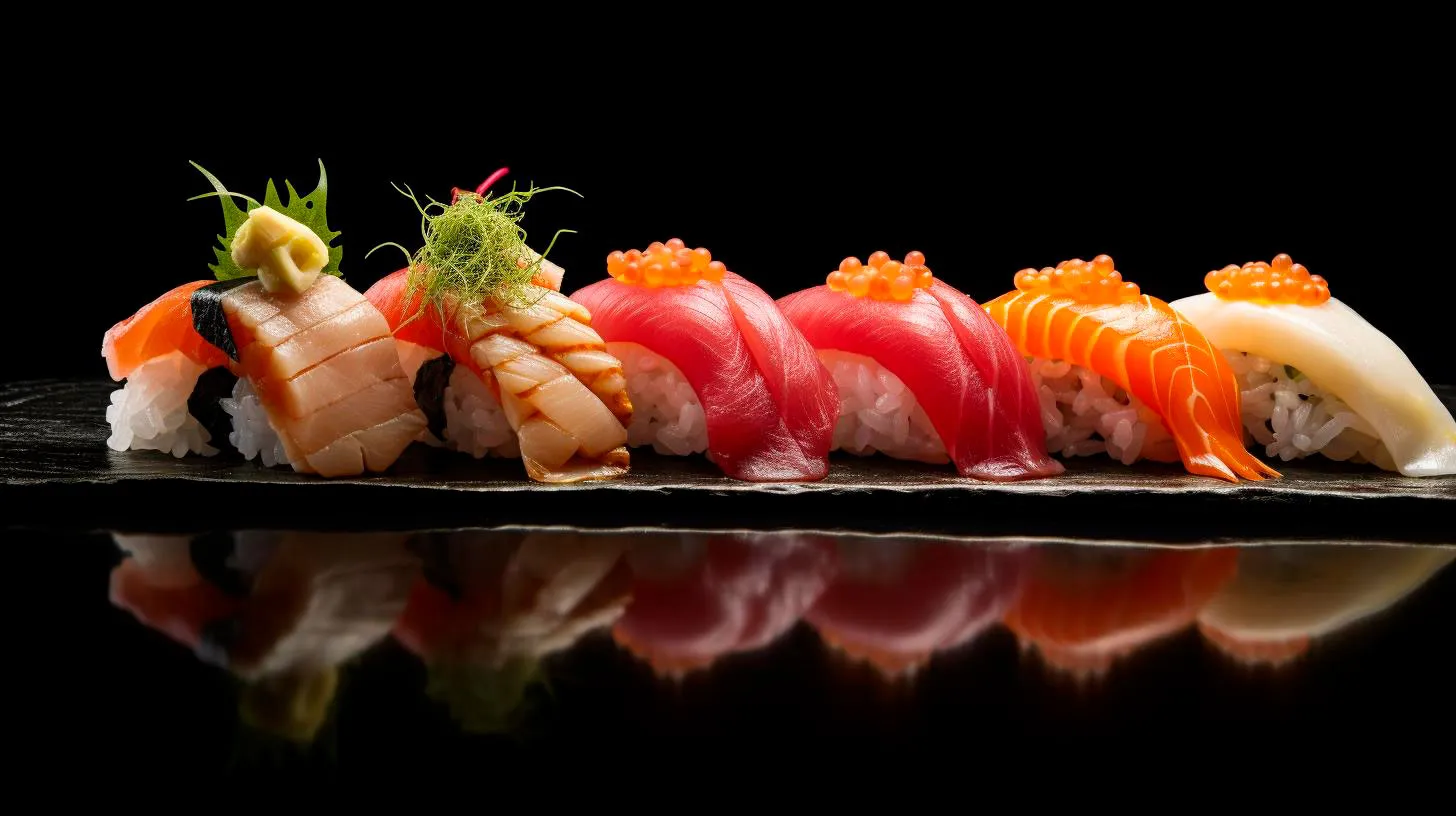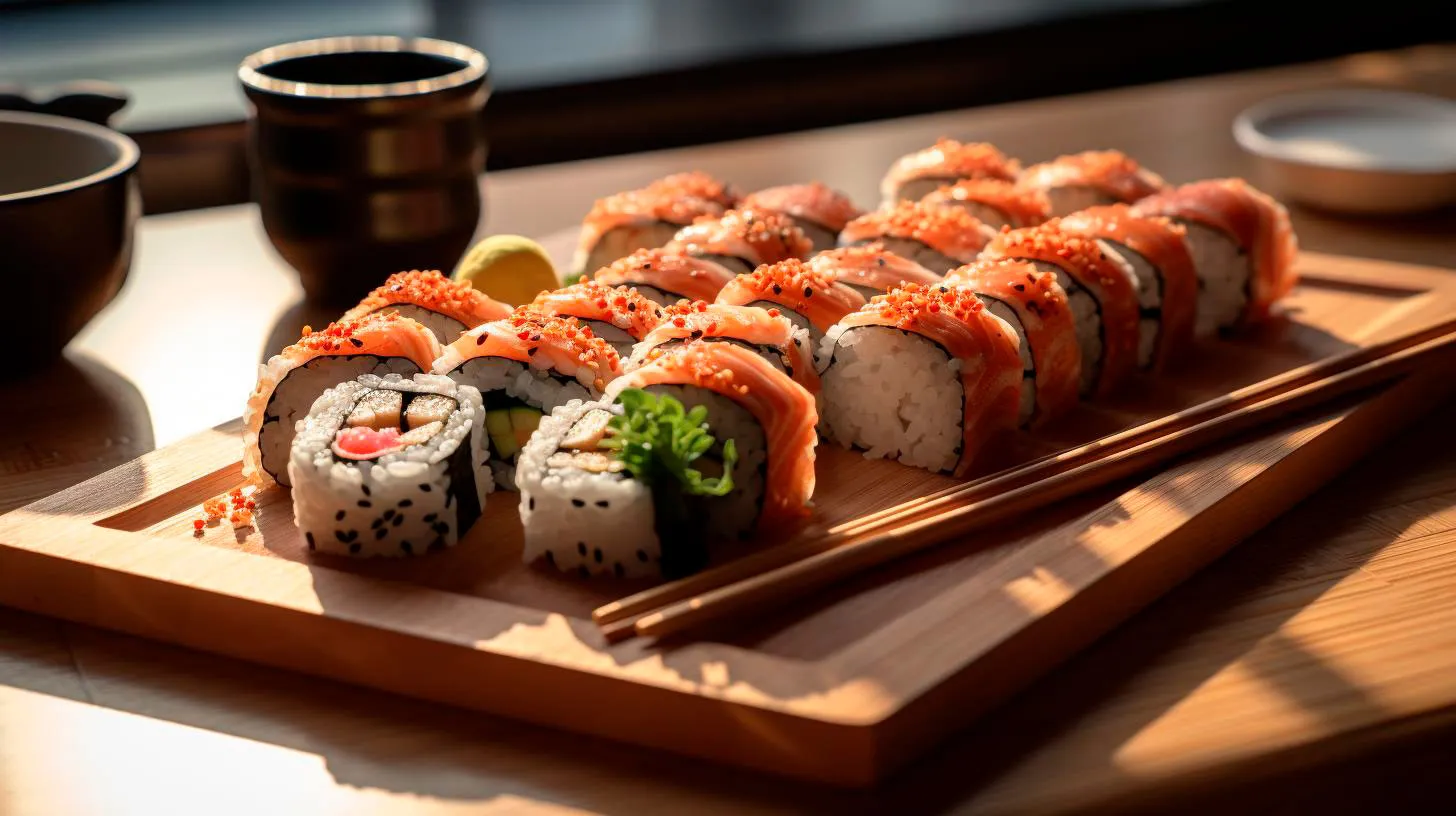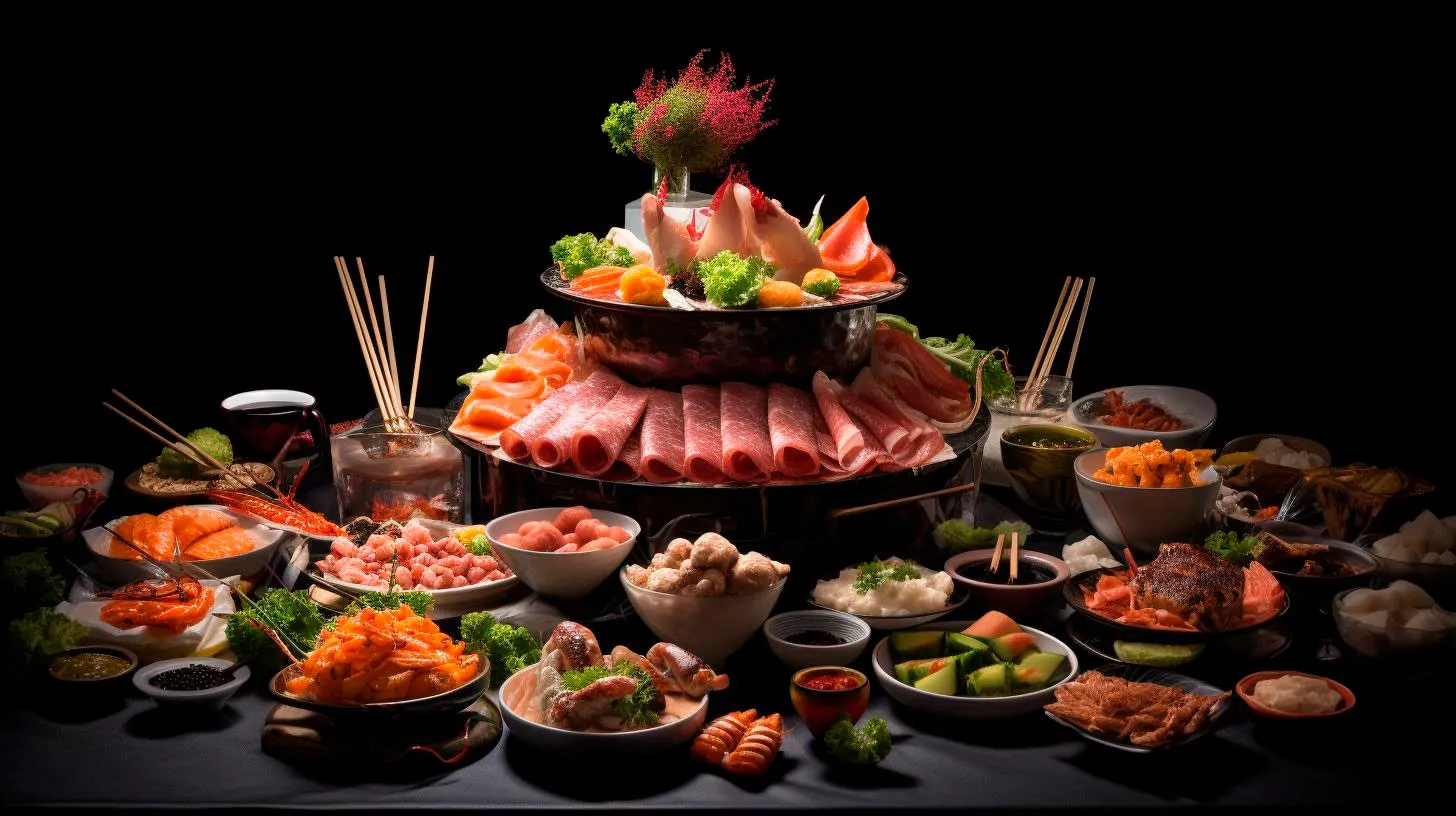Exploring the Origins of Sake and Nigiri Sushi
Let’s embark on this journey into the past and uncover the secrets behind these delectable delights.
The Origins of Sake
Sake, often referred to as Japanese rice wine, has a rich history dating back over two millennia. The exact origins of sake are somewhat shrouded in mystery, but it is believed to have first emerged during the Yayoi period (300 BCE – 300 CE) in Japan. Initially, it was consumed as a ritual offering to the gods and was later appreciated for its medicinal properties.
Over time, the brewing techniques of sake became more refined, and it transitioned into a beverage consumed for pleasure rather than solely for religious or medicinal purposes. Sake production spread throughout Japan, with different regions developing their own unique flavors and styles.
Key Takeaways:
- Sake originated during the Yayoi period in Japan, around 300 BCE.
- Initially used as a religious offering, sake later became a popular beverage.
- Various regions in Japan have distinct sake brewing traditions, resulting in diverse flavors.
Unveiling the History of Nigiri Sushi
Now, let’s shift our focus to the delightful world of sushi, particularly nigiri sushi. Nigiri sushi, the popular hand-pressed sushi that pairs a slice of raw or cooked seafood with a small mound of seasoned rice, has a fascinating history intertwined with cultural traditions and innovation.
The origins of sushi can be traced back to ancient Southeast Asia, where people first discovered the technique of preserving fish by fermenting it with rice. This preserved fish, known as narezushi, was initially consumed only after the rice had been discarded. However, over time, people started eating the rice alongside the fish, giving birth to the concept of sushi as we know it today.
During the Edo period (1603-1868) in Japan, sushi evolved further, and nigiri sushi gained significant popularity. Nigiri sushi was initially sold as street food, offering a quick and convenient way to enjoy this delectable combination of fish and rice. It quickly captured the hearts and taste buds of the Japanese people, eventually spreading worldwide.
Key Takeaways:
- Sushi originated in Southeast Asia as a method of preserving fish with rice.
- The concept of sushi evolved during the Edo period in Japan, with nigiri sushi gaining popularity.
- Nigiri sushi was initially sold as street food and became widely celebrated in Japan.
The Cultivation of Sake and Nigiri Sushi Across the Globe
Today, both sake and nigiri sushi have found a place not only in Japan but also in various countries around the world. Their popularity can be attributed to their unique flavors, cultural significance, and the skill involved in their preparation. Let’s take a closer look at how these beloved delicacies have spread globally.
Sake has gained international recognition as a premium beverage, enjoyed by both enthusiasts and novices. The global sake market continues to grow, with an anticipated compound annual growth rate (CAGR) of over 6% from 2021 to 2026. Japan, the United States, and China are the largest consumers and exporters of sake, while craft breweries are gaining traction in other countries, offering their spin on this traditional Japanese drink.
When it comes to nigiri sushi, it has become a staple in sushi restaurants worldwide, enticing food lovers with its simplicity and exquisite flavors. In recent years, global sushi consumption has surged, with the global sushi market projected to reach a value of $22.2 billion by 2025, growing at a CAGR of 5.74%. The United States, Brazil, and the United Kingdom are some of the top consumers of sushi outside of Japan, with an increasing number of sushi chains catering to the growing demand.
Key Takeaways:
- The global sake market is expected to grow at a CAGR of over 6% from 2021 to 2026.
- Nigiri sushi has become a popular choice in sushi restaurants worldwide.
- The global sushi market is projected to reach $22.2 billion by 2025, growing at a CAGR of 5.74%.
Conclusion
Exploring the origins of sake and nigiri sushi reveals a rich tapestry of history and cultural significance. From their humble beginnings to their widespread popularity today, these culinary treasures have captivated people’s palates across the globe. Whether you are sipping a glass of sake or savoring a piece of nigiri sushi, you are partaking in traditions that have withstood the test of time. So, the next time you indulge in these delightful delicacies, take a moment to appreciate the centuries of craftsmanship and culture that have made them what they are today.
Unveiling Hidden Harmonies: Discovering Unique Sake and Nigiri Sushi Combinations
Are you ready? Let’s dive in!
The Perfect Pairing: Sake and Nigiri Sushi
Sake, a traditional Japanese rice wine, and nigiri sushi, a beloved Japanese delicacy, go hand in hand. When paired thoughtfully, the flavors of sake and nigiri sushi complement each other, creating an unforgettable dining experience. Just like technology advances our modern world, embracing the harmony between sake and nigiri sushi can elevate your culinary encounters to new heights.
Understanding the Flavor Profiles
Before we proceed, let’s take a closer look at the flavor profiles of sake and nigiri sushi:
- Sake: Sake comes in various types, each offering distinct flavors. Junmai sake boasts a rich and earthy aroma, while Ginjo sake is known for its fruity and floral notes. On the other hand, Daiginjo sake tends to be more refined and elegant with a smooth finish. Understanding these profiles will help you choose the perfect sake for your nigiri sushi pairing.
- Nigiri Sushi: Nigiri sushi consists of a small mound of rice topped with delectable slices of fresh fish or seafood. The flavors of nigiri sushi can range from delicate and buttery to rich and umami. The choice of fish or seafood plays a vital role in the overall taste and texture of the nigiri sushi.
Unlocking Hidden Harmonies
Now that we have an understanding of the flavor profiles, let’s uncover some unique sake and nigiri sushi combinations that will leave your palate yearning for more:
1. Junmai Sake with Fatty Tuna (Toro) Nigiri
Key Takeaway: The rich, buttery texture of fatty tuna (toro) nigiri harmonizes beautifully with the earthy notes of Junmai sake.
2. Ginjo Sake with Salmon Nigiri
Key Takeaway: The fruity and floral flavors of Ginjo sake complement the delicate, buttery texture of salmon nigiri.
3. Daiginjo Sake with Scallop Nigiri
Key Takeaway: The refined and elegant nature of Daiginjo sake pairs perfectly with the subtle sweetness of scallop nigiri.
4. Honjozo Sake with Ebi (Shrimp) Nigiri
Key Takeaway: The clean and crisp taste of Honjozo sake harmonizes with the succulent and slightly sweet flavors of shrimp nigiri.
5. Kimoto Sake with Unagi (Grilled Eel) Nigiri
Key Takeaway: The complex flavors of Kimoto sake are an excellent match for the smoky and savory notes of unagi nigiri.
The Advantages of Exploring Sake and Nigiri Sushi Combinations
By venturing into the world of sake and nigiri sushi combinations, you open up a world of exciting advantages:
- Enhanced Dining Experience: Pairing sake with nigiri sushi elevates your dining experience, taking it to a whole new level of enjoyment.
- Flavor Exploration: Each combination offers a unique flavor profile, allowing you to explore the intricacies of taste.
- Perfect Balance: The harmonious fusion of sake and nigiri sushi ensures a perfect balance of flavors that will tantalize your taste buds.
Remember, each sake and nigiri sushi combination is a unique sensory experience, and exploring different options will add depth to your culinary journey.
Conclusion
In the vast world of gastronomy, the hidden harmonies between sake and nigiri sushi await discovery. With their distinct flavors and remarkable pairing potential, unlocking the perfect combination will take your taste buds on an adventure. Remember, choose your sake carefully, experiment with different fish or seafood, and uncover the hidden harmonies that make every bite unforgettable.
So, are you ready to embark on this culinary exploration? Let the hidden harmonies of sake and nigiri sushi inspire your dining experiences and captivate your senses like never before.
Mastering the Art of Sake Selection for Nigiri Sushi
However, with so many types and styles of sake available, it can be overwhelming to choose the right one. In this article, we will guide you through the process of mastering the art of sake selection for nigiri sushi, ensuring a harmony of flavors that will surely leave you craving for more.
Understanding the Basics of Sake
Before delving into the intricacies of selecting sake for nigiri sushi, it is essential to have a basic understanding of this traditional Japanese beverage. Sake is made from fermented rice and water, with various brewing techniques employed to create a wide range of flavors and aromas. The quality and type of rice, water, yeast, and the brewing process itself all play a crucial role in determining the final characteristics of the sake.
Here are some key points to keep in mind:
- Sake can be served either hot or cold, depending on personal preference and the type of sake
- The alcohol content of sake typically ranges from 15% to 20%
- Sake is often classified based on its polishing ratio, which refers to the extent to which the rice grain is milled before brewing
- There are several traditional sake styles, including Junmai, Honjozo, Ginjo, and Daiginjo, each with its own unique characteristics
The Art of Pairing Sake with Nigiri Sushi
Nigiri sushi, with its delicate balance of flavors and textures, pairs exceptionally well with a variety of sake styles. From light and fruity to dry and robust, the flavors of sake can enhance and complement the nuances of the sushi. Here are a few pointers to help you master the art of sake selection for nigiri sushi:
1. Consider the Fatty Fish
Since nigiri sushi often features fatty fish like salmon, yellowtail, or tuna, it is crucial to choose a sake that can cut through the richness of the fish. The acidity and crispness of a Junmai Ginjo or a Junmai Daiginjo sake can provide a perfect balance and enhance the flavors of the sushi.
2. Match Intensity and Umami
To create a harmonious pairing, it is essential to consider the intensity and umami of both the sushi and the sake. For example, a bold and flavorful piece of nigiri sushi, such as eel or sea urchin, pairs exceptionally well with a full-bodied Junmai or Kimoto sake.
3. Play with Contrasting Flavors
While matching flavors can result in a successful pairing, contrasting flavors can also create an exciting tasting experience. For nigiri sushi with tangy toppings like pickled vegetables or ponzu sauce, a slightly sweeter sake like a Nigori or a Yamahai can provide an interesting contrast.
4. Seek Expert Recommendations
If you’re new to the world of sake, don’t hesitate to ask the sushi chef or a sake sommelier for their recommendations. These experts can guide you towards finding the perfect sake that complements the nigiri sushi you’ve chosen.
Key Takeaways
With its rich history and diverse range of flavors, sake is a perfect companion to nigiri sushi. However, mastering the art of sake selection takes time and practice. Here are some key takeaways to remember:
- Understanding the basics of sake, including its classification and brewing process, is essential for making informed choices
- Pair sake with nigiri sushi based on the fatty fish, intensity, umami, and flavor contrasting
- Don’t hesitate to seek expert recommendations from sushi chefs or sake sommeliers
As you embark on your journey to explore the world of sake and nigiri sushi, keep in mind that taste preferences can vary, and experimentation is key. Take the time to savor each combination and let your palate guide you towards discovering your own perfect pairing. So, the next time you enjoy a plate of nigiri sushi, remember to choose a sake that enhances the flavors and transports you to the authentic taste of Japan.
Elevating the Dining Experience: Sake and Nigiri Sushi Pairing
This exquisite combination brings together traditional Japanese flavors for a truly unforgettable dining experience. In this article, we will explore the art of sake and nigiri sushi pairing, its advantages, key takeaways, and why it is becoming a favorite among food connoisseurs.
The Perfect Combination
Sake, a Japanese alcoholic beverage made from fermented rice, has a rich history dating back thousands of years. It is often enjoyed on its own or used as a complement to a variety of Japanese cuisine. When paired with nigiri sushi, the intricate flavors of both the sake and sushi meld together, creating a delightful and harmonious tasting experience.
Nigiri sushi, a traditional style of sushi made with a small finger of rice topped with various seafood or other ingredients, provides the perfect canvas for exploring the nuances of different sake varieties. The delicate and subtle flavors of nigiri sushi are elevated when paired with the right sake selection, resulting in a truly remarkable gastronomic journey.
The Advantages of Sake and Nigiri Sushi Pairing
There are several advantages to indulging in the exquisite combination of sake and nigiri sushi. Here are a few key points to consider:
- Enhanced Flavor: The complex flavors of sake and nigiri sushi complement each other, enhancing the overall taste experience. The pairing brings out the umami flavors of both, creating a harmonious blend on the palate.
- Balance and Contrast: Sake’s subtle sweetness can balance the saltiness of certain types of nigiri sushi. Additionally, the contrast between the cool, refreshing sake and the warm, tender rice of nigiri sushi adds an extra layer of sensory delight.
- Expanding Culinary Horizons: Pairing sake with nigiri sushi introduces diners to new and unique flavor profiles. It allows for exploration beyond the typical soy sauce and wasabi accompaniments, offering a heightened appreciation for the intricacies of Japanese cuisine.
Key Takeaways
Pairing sake with nigiri sushi elevates the dining experience by bringing together the finest elements of Japanese cuisine. Here are some key takeaways to remember when exploring this exquisite combination:
- Experiment with different varieties: Try pairing different types of sake with a variety of nigiri sushi to discover your personal preferences. Sake can range from light and smooth to bold and robust, offering endless possibilities.
- Consult with experts: Seek advice from knowledgeable staff or sushi chefs at restaurants specializing in sake and nigiri sushi pairing. They can guide you through the selection process, ensuring the perfect match for your taste buds.
- Step out of your comfort zone: Be open to trying new flavors and combinations. Sake and nigiri sushi pairing provides an opportunity to expand your culinary horizons and discover hidden gems.
In conclusion, elevating the dining experience through sake and nigiri sushi pairing is a trend that continues to enthrall food enthusiasts around the world. With its complementary flavors, sophisticated presentation, and the ability to create a gastronomic journey, this combination offers a unique experience that is unrivaled in the world of Japanese cuisine. So, the next time you visit a sushi restaurant, consider exploring the diverse realm of sake and nigiri sushi pairing to truly elevate your dining experience.



